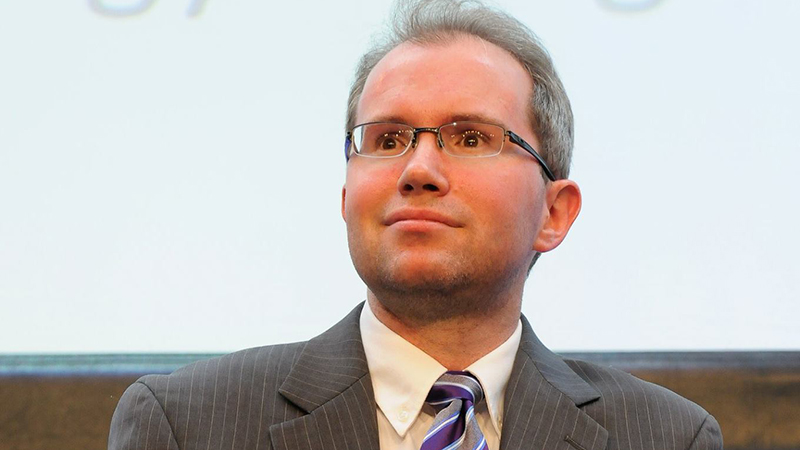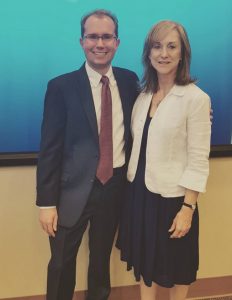
Twice a week, at precisely 11:30 a.m., dozens of IT employees at the FCC emerge from their offices and make their way to a central hallway cross section in the heart of FCC headquarters in Washington, D.C. A large white board hangs on a wall in the center of the main gathering place, detailing a dozen major IT projects in priority order. Beneath the white board, white tape outlines an ‘x’ on the floor.
FCC Chief Information Officer David Bray stands directly across from the white board. “Who’s up first?” he shouts, referencing the highest priority project listed on the board. MeriTalk was granted exclusive access to this so-called FCC IT Team Boardwalk meeting and has agreed not to disclose the details of the projects discussed. One by one, Bray’s team make their way to stand on the ‘x’ and provide a detailed status update on their work to date. Bray, standing with his senior deputies, spends most of his time focusing on what, if anything, his project leaders need to keep pressing forward.
It’s an amazing scene. One would be hard-pressed to recognize it, but about half of the 60 people standing in the hallway are private sector contractors. To Bray, however, it is one team pressing forward with a diversity of viewpoints and what could be an unprecedented amount of autonomy to achieve one mission. When the meeting ends, I ask Bray about this style of leadership. He smiles and shakes his head. “It’s amazing,” he said. “Government can do great things. You just need to get out of its way sometimes.”
Bray, who’s been an outspoken proponent of creating so-called #ChangeAgents at every level of an agency’s organizational structure, is bringing his unique brand of thinking to this year’s Executive Leadership Conference (ELC), an annual event hosted by the American Council for Technology-Industry Advisory Council (ACT-IAC) that brings 800 government and industry executives together for two and a half days of leadership development and collaboration. In an extensive interview following the IT Boardwalk session, Bray outlined his plans for shaking things up at ELC.

“After the 2015 ELC, they came to me and asked if I would like to chair the next conference. First, I needed to know who my industry chair was. And second, I would only do it if we promised that 50 percent of the speakers would be women, 25 percent or more would be Gen X or Gen Y, and 25 percent or more were from outside of D.C.,” Bray said.
He got what he wanted. Teresa Bozzelli, senior vice president of Sapient Government Services, was chosen to serve as his industry chair, and ACT-IAC agreed to their diversity goals.
What’s New At ELC 2016?
“This year there’s going to be a lot fewer monologue talks,” Bray said. Instead, the agenda calls for a series of TED-like talks, called Voices of Change, that will each be 12 minutes long.”You get 12 minutes to talk and there will be 8 minutes for questions. The Voices of Change are meant to take an existing effort in public service that can scale and actually make us more impactful in 2017,” he said.
This year the audience will get to vote for their favorite talks through a new app. The winning entries will then get to present their proposals to the next administration in February or March.
The afternoon sessions will offer three-person panels that will each span 12 minutes in a shark-tank setting, and will cover what panelists think OMB and the new administration should do differently in 2017. The sharks will then get to ask questions about how the ideas could be made better. Then the audience gets to vote again. Those winning entries also get to present to the next administration through OMB and the next Federal CIO.
“We made sure we had diversity among the presenters, so these are names that you normally wouldn’t hear at ELC,” said Bray. “And all of these presentations will be for attribution. In the past, a lot of ELC was not for attribution.”
The overriding goal for ELC this year, according to Bray, it to “tee things up” for the next administraton. “In the past, the primary reason people went was to social network. I think that will still happen, but I think this year will be about actionable things that we can do,” he said.
“We really stand at a critical juncture. The reality is, when the last presidential transition happened, most people didn’t have a smart phone. And now there’s an expectation that you’re going to be able to access public services on your smart phone. And that’s just eight years. And so we’re at this critical juncture at which the speed of change is accelerating as is the expectations of what public service can do,” said Bray. “At the same time our budgets are flat, if not declining. Workforce numbers possibly declining. So how can we thrive in this exponential era so that 10 years from now we’re not having the same conversations we’re having at ACT-IAC today.”
For Bray, there’s either a good future or a not so good future waiting just over the horizon for both the government and the public that it serves. And the outcome really depends on the ideas that attendees and presenters at ELC can develop for 2017 and beyond.
The conference will also bring together experienced leaders and younger leaders on the same stage to discuss what each generation is taking away from the conference. “It’s meant to inform each other. Because the reality is that people see the world differently, and that’s good,” Bray said. “But often times we don’t have a conversation about those differences.”
